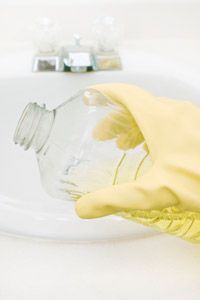Chemical Drain Cleaners
Be they liquid, gel or powder form, most of the drain cleaners you'll find on store shelves use strong chemicals, and they come in liquid, gel and powder forms. All chemical reactions involve moving electrons, and drain cleaners work by either taking or giving electrons to the clogging substance, generating heat in the process. There are three main types of drain cleaners:
- Caustic drain cleaners contain substances such as lye and caustic potash. They're bases, so they give electrons to the clogging substance, and their hydroxide ions create the reaction that clears the clog. Their alkaline, or basic, chemicals release heat and turn grease into a soap-like substance that's more easily dissolved. These drain cleaners are typically heavier than water, which enables them to reach the clog through standing water.
- Oxidizing drain cleaners contain substances such as household bleach, peroxides and nitrates. These chemicals cause the organic material of the clog to lose electrons and become oxidized. The product is heavier than water, so it can move through standing water, and it releases heat and gas to help clear the blockage.
- Acid drain cleaners aren't commonly found in stores, and some are sold only to plumbers. These typically contain high concentrations of sulfuric acid or hydrochloric acid, substances that increase hydronium ions in a solution and attract electrons from the clog. The hydronium ions react chemically with the material in the clog, and the reaction releases heat, which is necessary to melt congealed grease [source: Sheridan].
Because most of these products generate heat, they may soften the polyvinyl chloride, or PVC, pipes found in homes today. However, such damage is rare if you use the drain cleaner as directed -- damage is more likely to occur when drain cleaner is used on older, metal pipes.
Advertisement
Aside from their effect on pipes, there are other disadvantages to chemical drain cleaners. They're extremely toxic if swallowed, and they can burn eyes, skin and mucous membranes and eat through clothing. They can release noxious fumes, and if used improperly, they can cause explosions. These products can also harm septic systems by killing beneficial bacteria, and they can mar bathroom and kitchen fixtures.
If you use chemical drain cleaners, read the directions carefully and heed all the warnings. Use the product in a well-ventilated area, wear rubber gloves, and keep children and pets away from the drain. Never mix different drain cleaners, and don't use a plunger in conjunction with drain cleaners.
Most drain cleaners advise waiting 15 minutes or more after pouring the product into the drain before flushing it with hot water. If your drain is still clogged afterward, you may need to repeat the process.
Read on to learn about alternative drain cleaners.
